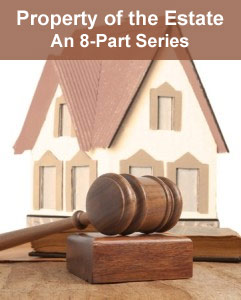#1 of 8 in Series
Property of the Estate in Bankruptcy: Difference between Chapter 7 and Chapter 13
 The goal of any chapter of bankruptcy is to try and settle debt with creditors. The difference between chapters 7 and 13 is how creditors go about looking for money. Ch13 is a wage-earner plan, in that you have a job and are making money or because you have assets you want to protect – that you don’t want liquidated, or because you want to deal with tax issues, or divorce issues, or to save a house, or to lower the payment on a car.
The goal of any chapter of bankruptcy is to try and settle debt with creditors. The difference between chapters 7 and 13 is how creditors go about looking for money. Ch13 is a wage-earner plan, in that you have a job and are making money or because you have assets you want to protect – that you don’t want liquidated, or because you want to deal with tax issues, or divorce issues, or to save a house, or to lower the payment on a car.Bankruptcy Code has Broad Definition of Property
In a Chapter 7 bankruptcy, possessions are defined as property owned on the date the case is filed.
In a Chapter 13 case, the law states, “Not only does it include 541 properties, it also includes all property the debtor acquires after the case is filed, but before the case is closed, dismissed, or converted to another section.”
Property Includes All of Debtor’s Legal and Equitable Interests
However, the bankruptcy code does allow you to get some of that property back, they can’t liquidate everything. Property of the bankruptcy estate is what the court is generally going to keep to pay money back to creditors, what they are going to try and sell.
Here’s how to look at it: If the court was going to sell everything, your clothes, your bed, your pots and pans, etc., and leave you with nothing, you’d have to buy some things to replace that property, it would be on credit, and you’d be right back where you started.
Property Does Not Include Specific Funds and Financial Assets
- Any Retirement account (IRA, 401K, PERF)
- Up to $17,600 of equity in your house (as a married couple, that would double to $35,000)
- $9,350 of personal tangible property
- $700 of intangibles ($350/person), which can include:
- cash
- stocks and bonds
- lawsuits settlements
- accounts receivable
- anticipated tax refund
- inheritance
- life insurance with a cash surrender value
- investments
Next Article in Series: Debtor in Bankruptcy Must Disclose All Assets and Liabilities or Risk Severe Penalties
* Source: Cornell University Law School Legal Information Institute
** Source: Justia
Disclosure required by 11 U.S.C. § 528(a)(3): We, the law office of Tom Scott & Associates, P.C., are a debt relief agency. We help people file for bankruptcy relief under the Bankruptcy Code.